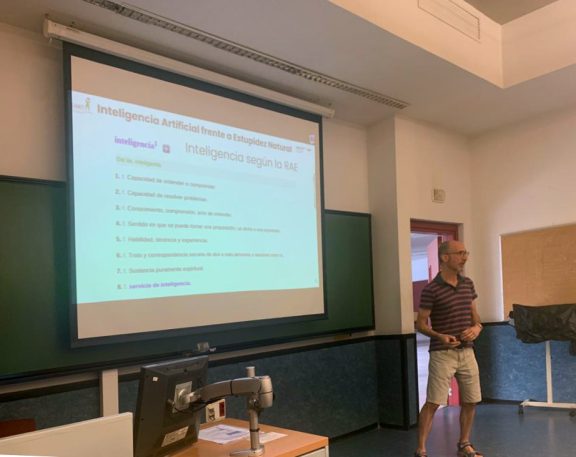The integration of artificial intelligence promises to revolutionize the way we learn and teach. This is the starting point of the talk "Artificial Intelligence versus Natural Stupidity, choose your friends for the journey you are about to start" that Óscar Belmonte, professor of Computer Languages and Systems and co-director of the Cuatroochenta Chair, gave on July 12 at the II Conference "Artificial Intelligence and English Teaching: opening doors to new opportunities" at the Universitat Jaume I (UJI) in Castelló.
Challenges of AI in education
It is undeniable that AI is bringing about changes in virtually all areas of life, and education is no stranger to this change. On the contrary, AI is driving the education community to introduce modifications to the way we teach and the way we do everyday tasks.
To discover what changes and how they should be implemented, according to Belmonte, the difference between artificial intelligence and human intelligence must first be well understood. Examples such as Marie Sklodowska Curie, Garry Kasparov or Miguel de Cervantes, among others, give us ample proof of human intelligence, but the question is, how far can AI go?


«The conflict presented by AI is not that it can replace us, but that we must develop an ethical framework for its management, and learn to educate it so that it does not continue incorrect human behavior patterns or contain biases (gender, ethnic, political or religious).»
One of the most popular AI tools that can be of great use in education is Chat GPT. It is a language system trained with millions of data and developed to maintain conversations with humans, provide ideas and information, among many other possibilities. It is not a traditional chatbot system with automatic responses like the ones we knew until now, but the model gets better the more information it incorporates. It is based on stochastic neural networks, i.e. it works with a structure similar to that of the neurons in the human brain and combines the theories of probability and statistics to analyze random phenomena. It is what is known in science as an LLM (large language model).
The possibilities are available to the educational community and discovering new applications is a challenge for everyone. From simple proposals such as translation, brainstorming to solve problems, document synthesis or the creation of study materials, the possibilities of chat applied to education are as many as our imagination allows. The key is to turn AI into a travel companion in the classroom and use it as an assistant that can improve the way we plan, teach and learn.In addition to Chat GPT, there are other solutions and their applications include use in space and in fields as diverse as medicine and health.
AlphaFold, developed by Google's DeepMind, is an AI that has enabled such relevant discoveries as predicting the 3D structure of millions of proteins from their amino acid sequences. This discovery has triggered a multitude of research projects in which these chains are the protagonists, opening new paths in the treatment of diseases such as Parkinson's or initiating a new era in molecular biology.
How is the Cuatroochenta Chair including AI in its projects?
The Cuatroochenta Chair has been developing different research projects related to AI and improvements in the quality of life of the elderly. One of them is Senior Monitoring whose objective is the early detection of mild cognitive decline. Another is Serena, a conversational chatbot that through questions can determine the degree of social fragility of an elderly person. Through this solution, it seeks to detect situations of unwanted loneliness. More recently, Sally has been developed, a system that with the use of cameras and different AI algorithms can detect the physical frailty of the elderly and digitize the data to facilitate patient follow-up by healthcare professionals.